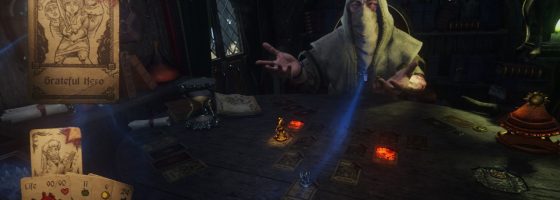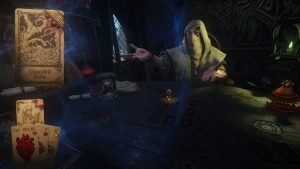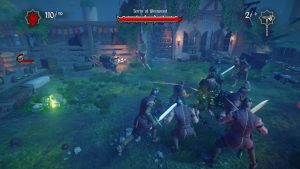Hand of Fate surprised everyone with its take on rogue-like design in 2015. Taking the concept of a card game to its logical conclusion, the game struck a balance between rogue-like exploration and deck building and card draw.
With the sequel, the developers have expanded on everything that worked (and didn’t) from the first game.
Setting the Table:
Hand of Fate 2’s story takes us back to the home of the mysterious game master from the first game. After his defeat at the end of Hand of Fate 1, he’s now back with a new game for you to play. As with Hand of Fate 1, everything in the game is represented by cards: The board, events, gear, enemies and so on.
At the start of each quest, you will create a “deck” for yourself of cards you would like to see appear during the quest. After that, the game master adds in his quest-specific cards and generates the board. The game is built around three key systems — combat, board movement, and games of chance.
Whenever you have a combat event, the game switches to a third person view for battle. Whatever gear you’ve bought or found during the quest will be equipped. Different pieces of gear will have unique bonuses towards different enemy types; with the game giving you a hint of the enemies for each quest.
On the board, you will consume food for every new card you reveal. Running out of food will cause you to lose health for each space taken, but you will not consume food for backtracking. New to Hand of Fate 2 is the resource “fame”, which is a prerequisite for wearing higher tier equipment.
Lastly, you will have games of chance that determine event outcomes. Returning from the first game is picking the success card out of a set of shuffled cards. For Hand of Fate 2, there is now dice rolling, a wheel of chance, and more.
If you enjoyed the first game, you’ll be happy to find that everything that worked has been improved.
A Great Game:
Hand of Fate 2 greatly improves on the best elements of the first game. Besides what I’ve mentioned, there are now companions who can join you for a quest. Each companion will engage in combat with you and provide bonuses towards specific games of chance.
The game’s persistent layer is back in the form of token challenges. Many cards in the game will have a token attached to them. By completing specific conditions, you’ll earn the token and unlock new cards for subsequent plays.
A new feature is rare cards in the form of platinum and brimstone cards. Platinum cards are special events that reward you greatly, while brimstone ones are an extra hard challenge with a unique reward. You can only equip a select few depending on the quest itself.
Speaking of quests, the quest design has seen a major improvement compared to the first game.
In Hand of Fate 1, the major difference between quests were what enemies you would fight and any curses (debuffs) that would get stuck on you. For the sequel, each quest now features unique situations and challenges.
One quest has you searching for blessings while dealing with blizzard events. Another has you trying to figure out who is a traitor in a group of thieves. Completely finishing a quest will require you to solve the bonus objective, and earn more cards in the process.
While all that is good, Hand of Fate 2 cannot escape the inherent frustration points returning from the first game.
Snake Eyes:
Hand of Fate 2 like the first game is built around random chance. While you can impact the board to some extent based on the cards in your deck, success or failure comes down to chance more than anything else.
This is a game where one bad event can easily erase the last ten minutes of progress. The games of chance are still polarizing thanks to how vital they are to see more of the game. In one example, there is an event where you have a 1/4 chance to succeed, and the event demands you do it twice.
Combat continues to be a drag thanks to how repetitive it is. The combat system remains largely untouched, with the exception being consumable items and your partner engaging the enemy. You are still going to spend several minutes mashing the attack button until you need to parry or dodge an attack.
I think I would have preferred smaller enemy groups and more variety instead of basic fighting with large groups. There are several new enemy types in Hand of Fate 2 that require additional steps to fight them, but it feels more like busywork than depth.
Setting up the Board:
In the end, Hand of Fate 2 does what every good sequel should — Iterate on the design and welcome new and existing fans. Just like the first game, the card aesthetic and foundation leaves a lot of room for post-release support and I hope the game does well for them.
Hand of Fate 2 is a great rogue-like for either the fans or people looking for something different out of the genre. For more on the game, you can watch my let’s play of it on the Game-Wisdom YouTube channel.





